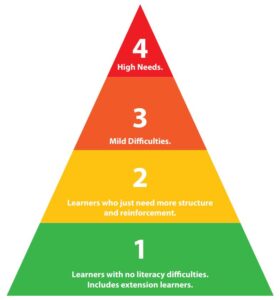
Thankfully, more and more schools are adopting a structured literacy approach – explicitly teaching phonic patterns in a logical, cumulative progression and actively developing the key phonological skills needed for literacy.
However, there are real challenges in achieving a fully inclusive approach.
One of the biggest challenges is the huge range of literacy levels and needs within the average classroom. An informal research study several years ago tested a whole year-group of seven and eight-year-olds and found that the literacy levels ranged from two years behind chronological age to four-and-a-half years above. In other words, there was a six-and-a-half year spread in literacy levels, even at that age! And, as we know, that problem simply compounds as they grow older.
The biggest difficulty for teachers is catering for the needs of each of those learners within the classroom. This is where I believe we need to change our approach. Waiting for a student to fail and then trying to ‘fix’ them is an approach with such negative consequences for both students and their teachers. And research shows that it’s an approach which rarely succeeds fully, leading to a situation where students are ‘trickle-fed’ with remediation throughout their primary years, but rarely fully catch up to where they should be.

Instead of allowing this situation to arise, we need to provide every learner with the right amount of support at each stage of their learning journey – and that will look very different for different members of your class!
We also need to enable every learner to progress at their own level and speed, which is something which is incredibly challenging when following a structured literacy approach.
It was, in fact, challenging enough when we had a ‘here’s your spelling list’ approach. By definition, that class spelling list was way too difficult for some students, but pathetically easy for others. At best, it probably catered ideally for less than a third of your class.
This article is from our Term 4 issue. Click here to read this issue online
My belief is that enabling every learner to work at their own level is best done by utilizing technology – in fact, there’s a pretty strong argument that technology is the only solution. How else can you teach every learner in the class at their own individual level and ensure that every learner is taught not only to read and spell those words, but also to understand their meaning and use them in context? The right technology, however, enables an inclusive approach – but also a fully scaffolded one.
Every learner is following the same progression, but some slower and with more support than others. Your extension learners can fly ahead, but your struggling learners will get the additional reinforcement they need to succeed. Good technology also enables you to work effectively in a literacy workstation environment, where some learners are working independently online, but others can be reading or doing written work, and some are being actively taught. After all, technology should never replace teaching, but good technology can replace a lot of the organisation and reinforcement involved.







